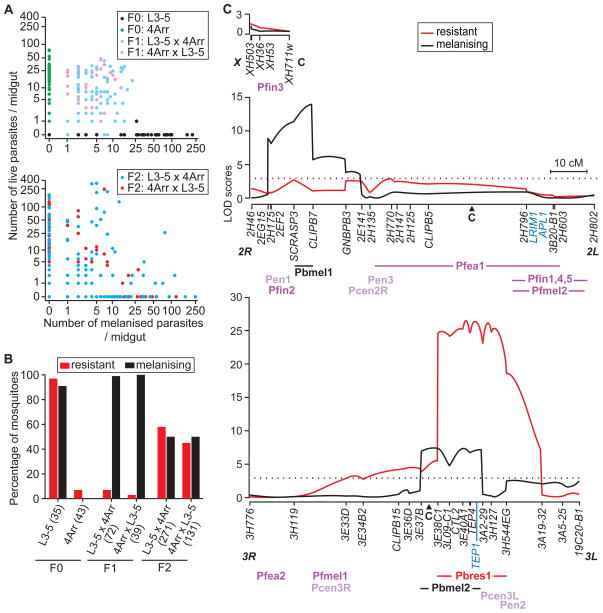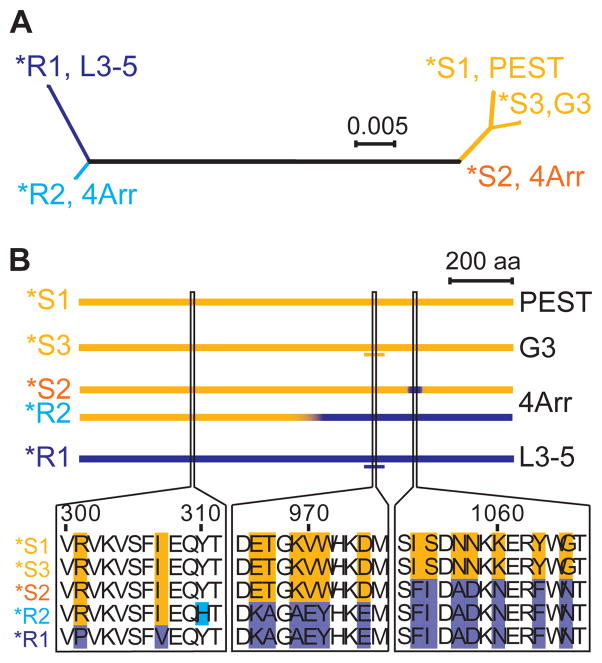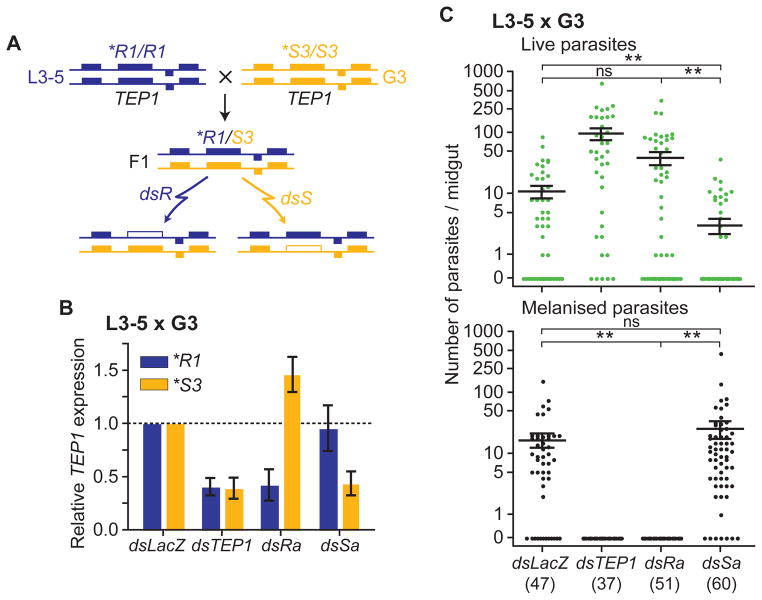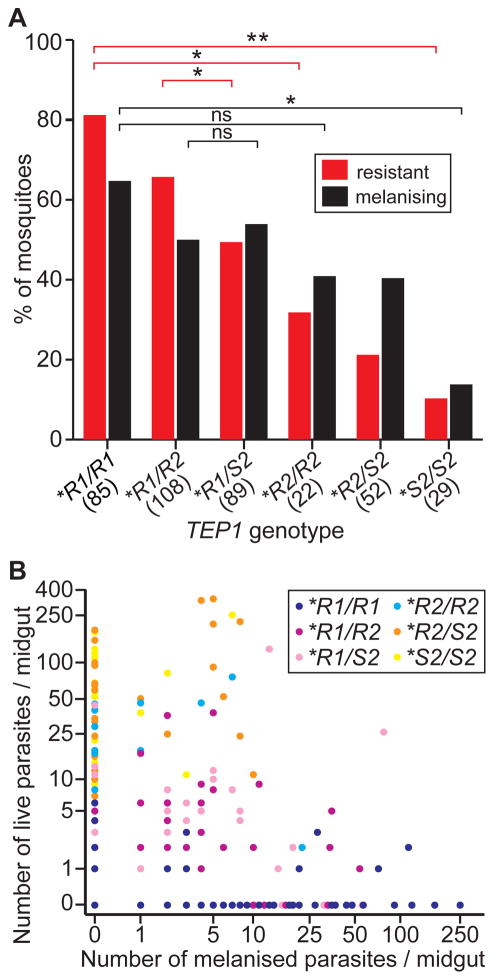Abstract
The ability of Anopheles gambiae mosquitoes to transmit Plasmodium parasites is highly variable between individuals. However, the genetic basis of this variability has remained unknown. We combined genome-wide mapping and reciprocal allele-specific RNA interference (rasRNAi) to identify the genomic locus that confers resistance to malaria parasites, and demonstrate that polymorphisms in a single gene encoding the antiparasitic thioester-containing protein 1 (TEP1) explain a substantial part of the variability in parasite killing. The link between TEP1 alleles and resistance to malaria may offer new tools for controlling malaria transmission. The successful application of rasRNAi in Anopheles suggests that it could also be applied to other organisms where RNA interference is feasible to dissect complex phenotypes to the level of individual quantitative trait alleles.
Anopheles gambiae mosquitoes are major vectors of Plasmodium falciparum, a protozoan parasite causing the most severe form of human malaria in Africa. The fact that mosquito strains completely wide variety of parasite species (1). Previous genetic analyses of crosses between this strain and the susceptible 4Arr strain infected with two simian parasite species focused on resistant to malaria parasites can be selected (1, 2) indicates that genetic factors in mosquitoes control the level of parasite transmission. Understanding the genetic basis of this resistance has been a long-standing question. The L3-5 resistant strain kills and melanises a the melanotic encapsulation phenotype and identified several quantitative trait loci (QTLs), whose relative contributions varied with parasite species and between F2 generation families (3, 4). Recently it became clear that melanisation occurs after parasite killing, as a means to dispose of dead parasites in some strains, while in others, killed parasites are only cleared by lysis (Fig. S2A) (5–7). In this study, we aimed at mapping the genomic regions and identifying genes that control resistance (i.e., the absence of live parasites) of mosquitoes to the rodent malaria parasite Plasmodium berghei.
We set up reciprocal crosses of the resistant L3-5 and susceptible 4Arr strains. F1 mosquitoes were intercrossed and individual females were isolated to lay eggs, yielding 10 F2 families. Females were blood fed on mice infected with PbGFPcon, a transgenic clone of P. berghei expressing GFP constitutively (8). Fluorescent live and dead melanised parasites were counted on dissected midguts 7 to 9 days post infection (Fig. 1A and supporting online text). As expected, parental L3-5 females displayed only melanised parasites (with the exception of one that bore one live parasite), and 4Arr mosquitoes displayed only live parasites. Most of the 111 F1 mosquitoes exhibited an intermediate phenotype (mix of live and melanised parasites). Both parental and F1 phenotypes were present in the 402 F2 females. Percentages of resistant (i.e. devoid of live parasite) and melanising (bearing at least one melanised parasite) mosquitoes in each generation (Fig. 1B) did not follow the segregation pattern of simple Mendelian traits (p-values < 0.001 in both cases (9)), indicating that the killing of P. berghei and the mode of clearance of dead parasites are complex traits that are each likely to result from the segregation of several alleles.
Fig. 1.
Loci associated with resistance and clearance of dead parasites. (A) Numbers of melanised (x-axis) and live (y-axis) parasites per mosquito in reciprocal crosses of the resistant L3-5 and susceptible 4Arr strains. (B) Percentages of resistant (devoid of live parasites) and melanising (bearing at least one melanised parasite) mosquitoes in each generation. (C) Linkage mapping for the resistant (red) and melanising (black) traits, with estimated LOD score thresholds represented as dotted lines (3.00 and 2.88, respectively). Genetic markers, centromere positions (C), chromosome arms and the TEP1, LRIM1 and APL1 loci (in cyan) are indicated below axes. Previously identified QTLs for resistance against simian parasites (light purple) or P. falciparum (dark purple) are positioned below chromosomes. The PRI corresponds to the region covered by the QTLs Pfin1, Pfin4, Pfin5 and Pfmel2.
To map loci controlling resistance to parasites, we genotyped 39 informative markers spanning the entire genome in 206 selected F2 individuals with extreme phenotypes (Fig. S1 and supporting online text). Linkage analysis comparing resistant and non-resistant mosquitoes identified a single region on chromosome 3L (Fig. 1C). We interpreted this region, covering approximately 19Mb, as a major locus responsible for resistance to P. berghei, and named it Pbres1, for P. berghei resistance locus 1. We further compared the genotypes of melanising and non-melanising mosquitoes, and detected two intervals that are likely to contain regulators affecting the mode of clearance of dead parasites, i.e., the balance between lysis and melanisation (Fig. 1C): a major QTL on chromosome 2R, which we named Pbmel1 (5Mb), for P. berghei melanisation locus 1, and a minor pericentromeric QTL on chromosome 3, Pbmel2 (17Mb), which partially overlaps with Pbres1. Linkage mapping using the actual counts of live or melanised parasites identified the same loci as above (Fig. S2B and supporting online text). Interestingly, the newly identified QTLs overlap with regions previously identified as controlling melanisation of P. cynomolgi and P. berghei in L3-5 mosquitoes (Fig. 1C) (3, 4, 10), indicating that the major mechanisms underlying parasite elimination in L3-5 are likely partially conserved and independent of parasite species. Nevertheless, clear quantitative differences exist between the four studies, probably, at least in part, because previous studies did not consider resistance and melanisation as distinct traits.
Because of its major role in parasite transmission, we investigated the resistance QTL on chromosome 3L in more detail. Pbres1 contains ~975 genes, among which 35 can be classified as “immune-related” (11). This category includes the gene encoding the thioester-containing protein 1 (TEP1), a complement-like molecule circulating in the hemolymph with key antiparasitic activity (12). Two features make it an attractive candidate: it binds to, and promotes the killing of midgut stages of the rodent parasite P. berghei, and it is highly polymorphic (5). To examine TEP1 polymorphism in the L3-5 and 4Arr strains, we cloned and sequenced the full ORF (Figs. 2 and S3). We renamed the previously known TEP1r (or TEP16) from the L3-5 strain (5, 13), TEP1*R1, and TEP1s (or TEP1) from the PEST strain (14), TEP1*S1. All TEP1 sequences in L3-5 mosquitoes were identical to *R1. Sequences from the 4Arr strain appeared to be chimeras of TEP1*S and TEP1*R: one was closer to *S1, we named it TEP1*S2; the second allele clustered with *R1 in the phylogenetic tree, and was therefore named TEP1*R2. We also sequenced TEP1 from our G3 colony and confirmed that it was closely related, although not identical, to TEP1*S1. We named this allele TEP1*S3.
Fig. 2.
TEP1 polymorphism. (A) Phylogenetic tree built from the global alignment of complete amino acid sequences of TEP1 alleles from L3-5 (*R1), 4Arr (*R2 and *S2) and G3 (*S3) mosquitoes and the previously described *S1 allele from the PEST strain. Scale bar: estimated amino acid substitutions per site. (B) Schematic representation of TEP1 sequences. Amino-acid sequences of *S1 and *S3 are represented by orange horizontal bars, *R1 by a blue bar. The 4Arr alleles are combinations of *S1/S3 and *R1, as illustrated by short stretches of aligned sequences. The short horizontal lines below *R1 and *S3 indicate the regions targeted by dsRa and dsSa, respectively.
To determine whether the diverse alleles of TEP1 have a phenotypic effect, we compared the degree of resistance of mosquitoes that differed solely in the expression of TEP1 alleles. For this, we developed an assay similar to reciprocal hemizygosity analysis in yeast (15): we used reciprocal allele-specific RNA interference instead of chromosomal deletions to silence each allele separately in F1 mosquitoes, enabling to compare the function of each allele in the same genetic background (Fig. 3A). We crossed resistant L3-5 and susceptible G3 mosquitoes as these strains are homozygous for TEP1, and bear representative alleles of the TEP1*R and TEP1*S classes. We also note that G3 and 4Arr mosquitoes share the same susceptible phenotype.
Fig. 3.
TEP1*R1 is more efficient than TEP1*S3 in parasite killing. (A) Reciprocal allele-specific RNAi. Each box represents a gene. With the use of short dsRNA probes specifically directed against *R1 (dsR) or *S3 (dsS), each TEP1 allele is silenced separately in F1 mosquitoes (open box) allowing to compare the function of each allele in the same genetic background. (B) TEP1 expression in the F1 progeny of crosses between L3-5 females and G3 males (L3-5 x G3) was measured by allele-specific quantitative real-time PCR 3 days after dsRNA-treatment. Expression levels of TEP1*R1 and *S3 were normalized to their levels in the dsLacZ control. Mean (central bar) ± SEM (error bar) of three independent experiments. (C) Parasite counts in the F1 progeny of L3-5 x G3. Results of three independent experiments were pooled, sample sizes are shown in brackets. Mean (central bar) ± SEM (error bar). Significance for differences between groups are indicated (Mann-Whitney on key comparisons): **, p<0.001; ns, not significant.
We designed three pairs (a–c) of short dsRNAs (dsR/dsS) targeting specifically *R1 and *S3, and tested them in the parental L3-5 and G3 strains (Fig. S4 and supporting online text). We used dsLacZ as a negative control, and dsTEP1 that targets both alleles as a positive control (5). Pair a (dsRa and dsSa) was selected for further experiments: 3–4 days after dsRNA treatment, TEP1*R1 was depleted from L3-5 mosquitoes upon treatment with dsRa but not dsSa, and reciprocally, injection of dsSa but not dsRa in G3 mosquitoes reduced TEP1*S3 levels. In the F1 progeny of reciprocal crosses between L3-5 and G3 mosquitoes, both alleles were silenced to a similar level by allele-specific RNAi, allowing to specifically study the function of each allele (Figs. 3B, S4B and supporting online text).
DsRNA-treated F1 mosquitoes were infected on mice carrying PbGFPcon (Figs. 3C and S4C). Control dsLacZ-treated F1 mosquitoes bore a mixture of live and melanised parasites. *R1-depleted mosquitoes (dsRa) were significantly more susceptible than *S3-depleted (dsSa) mosquitoes, and were completely unable to melanise. Moreover *S3-depleted mosquitoes were consistently more resistant than dsLacZ controls, containing fewer live parasites. Thus TEP1*R1 is more efficient than TEP1*S3 in promoting parasite killing and melanisation of dead parasites. The reversal of the F1 phenotype towards the susceptible parent phenotype upon depletion of TEP1*R1, or towards the resistant parent phenotype upon depletion of TEP1*S3, indicates that polymorphisms in TEP1 are a major determinant of resistance to P. berghei in these mosquito strains.
To examine whether the two allelic variants of the 4Arr strain, *S2 and *R2, which belong to the TEP1*S and TEP1*R classes, also differ in their efficiency in parasite killing, we further refined our association analysis of the F2 progeny of the QTL mapping crosses, and genotyped all F2 progeny for TEP1 (Fig. 4 and supporting online text). Most *R1/R1 F2 mosquitoes (81%) were fully resistant, and those that were not carried only a few live parasites. In contrast, 90% of *S2/S2 mosquitoes were susceptible, containing high parasite loads. *R2/R2 mosquitoes had an intermediate phenotype, suggesting that although *R2 is closely related to *R1, the few polymorphisms between these two alleles affect its efficiency in parasite killing. Further studies are required to precisely identify the essential SNP(s) and the molecular mechanisms that underlie this resistance. In addition, *R1/R2 mosquitoes were more resistant than *R1/S2 mosquitoes, indicating that the two 4Arr alleles confer different degrees of resistance, with *R2 > *S2. Thus the complexity of the resistance inheritance in our crosses is partially explained by the segregation of the three TEP1 alleles. Still, other genes besides TEP1 must contribute. This is apparent from comparing phenotypes of groups from different generations with the same TEP1 genotypes (Figs. 1B and 4A): e.g. 50–70% of *R1/R2 and *R1/S2 mosquitoes were resistant in F2, while <7% were resistant in F1. Thus, this additional locus/loci appear to be unlinked to TEP1, and to have a limited impact in mosquitoes homozygous for the extreme alleles *R1 and *S2, which have similar resistance as the parental strains, but are essential to support resistance in heterozygotes. Future work may focus on identifying secondary QTL(s) and potential candidate TEP1 suppressor gene(s).
Fig. 4.
Correlation between TEP1 genotype and phenotype upon P. berghei infection in the F2 generation. (A) Percentages of resistant and melanising mosquitoes for each genotype. Sample sizes are shown in brackets. Significance for differences between groups were calculated taking into account F2-family structure (9): **, p<0.001; *, p<0.05; ns, not significant. (B) Parasite counts in F2 mosquitoes as in Fig. 1A.
Importantly, the single locus identified here that controls resistance to P. berghei and includes TEP1, does not overlap with previously reported QTLs controlling the intensity of infection of natural populations by the human malaria parasite P. falciparum, and in particular, not with the major Plasmodium resistance island (PRI) (16–18) (Fig. 1C). Two leucine-rich repeat proteins encoded in the PRI, APL1 and LRIM1, form a complex with TEP1. These proteins maintain mature TEP1 in circulation and regulates its binding to parasites and their subsequent killing (19, 20). Polymorphisms in proteins that control TEP1 function, or in TEP1 itself, might both contribute to the efficiency of TEP1 antiparasitic activity. The differences between the QTLs identified in laboratory strains and in field mosquitoes might thus reflect the sampling of determinant polymorphism(s) in various players of the same pathway, rather than different mechanisms employed to limit development of human and rodent malaria parasite species. Consistently, silencing of TEP1 increases A. gambiae susceptibility to both murine and human Plasmodia (5, 21). Haplotypes of the “susceptible” and “resistant” alleles of TEP1, as well as recombinants between these forms, exist in field populations from East and West Africa (22). Understanding the genetic basis of resistance to malaria parasites, and how the determinant polymorphisms are maintained and selected in field populations, will be of tremendous importance for the control of malaria transmission.
Supplementary Material
Acknowledgments
We thank A. Cohuet for sharing sequencing information, R. Carmouche and J. Luis from the EMBL Genecore facility for support with genotyping, R. Bourgon for advice on statistical analyses, A. Budd for suggestions on the phylogenetic analysis, D. Doherty and J. Soichot for help with breeding mosquitoes and E. Marois and C. Ramakrishnan for comments on the manuscript. We acknowledge the support of F. Kafatos, in whose laboratory this work was initially carried out. This work was supported by grants from the NIH and the Deutsche Forschungsgemeinschaft (L.M.S.), CNRS and INSERM (E.A.L. and S.A.B), the European Molecular Biology Organization Young Investigator Program (E.A.L.), and the European Commission Network of Excellence “BioMalPar” (E.A.L.). S.A.B. received a postdoctoral fellowship from EMBO. E.A.L. is an international HHMI research scholar. EMBL Nucleotide Sequence Database accession numbers for TEP1 alleles sequenced in this report: FN431782 – FN431785.
Footnotes
Summary sentence: Polymorphisms in a mosquito complement-like factor confer resistance to malaria parasites.
References and Notes
- 1.Collins FH, et al. Science. 1986 Oct 31;234:607. doi: 10.1126/science.3532325. [DOI] [PubMed] [Google Scholar]
- 2.Vernick KD, et al. Exp Parasitol. 1995 Jun;80:583. doi: 10.1006/expr.1995.1074. [DOI] [PubMed] [Google Scholar]
- 3.Zheng L, et al. Science. 1997 Apr 18;276:425. doi: 10.1126/science.276.5311.425. [DOI] [PubMed] [Google Scholar]
- 4.Zheng L, et al. BMC Genet. 2003 Oct 24;4:16. doi: 10.1186/1471-2156-4-16. [DOI] [PMC free article] [PubMed] [Google Scholar]
- 5.Blandin S, et al. Cell. 2004 Mar 5;116:661. doi: 10.1016/s0092-8674(04)00173-4. [DOI] [PubMed] [Google Scholar]
- 6.Volz J, Muller HM, Zdanowicz A, Kafatos FC, Osta MA. Cell Microbiol. 2006 Sep;8:1392. doi: 10.1111/j.1462-5822.2006.00718.x. [DOI] [PubMed] [Google Scholar]
- 7.Shiao SH, Whitten MM, Zachary D, Hoffmann JA, Levashina EA. PLoS Pathog. 2006 Dec;2:e133. doi: 10.1371/journal.ppat.0020133. [DOI] [PMC free article] [PubMed] [Google Scholar]
- 8.Franke-Fayard B, et al. Mol Biochem Parasitol. 2004 Sep;137:23. doi: 10.1016/j.molbiopara.2004.04.007. [DOI] [PubMed] [Google Scholar]
- 9.Materials and methods are available as supporting material on Science online.
- 10.Gorman MJ, Paskewitz SM. Am J Trop Med Hyg. 1997;56:446. doi: 10.4269/ajtmh.1997.56.446. [DOI] [PubMed] [Google Scholar]
- 11.Waterhouse RM, et al. Science. 2007 Jun 22;316:1738. doi: 10.1126/science.1139862. [DOI] [PMC free article] [PubMed] [Google Scholar]
- 12.Blandin SA, Marois E, Levashina EA. Cell Host Microbe. 2008 Jun 12;3:364. doi: 10.1016/j.chom.2008.05.007. [DOI] [PubMed] [Google Scholar]
- 13.Baxter RH, et al. Proc Natl Acad Sci U S A. 2007 Jul 10;104:11615. doi: 10.1073/pnas.0704967104. [DOI] [PMC free article] [PubMed] [Google Scholar]
- 14.Levashina EA, et al. Cell. 2001 Mar 9;104:709. doi: 10.1016/s0092-8674(01)00267-7. [DOI] [PubMed] [Google Scholar]
- 15.Steinmetz LM, et al. Nature. 2002 Mar 21;416:326. doi: 10.1038/416326a. [DOI] [PubMed] [Google Scholar]
- 16.Niare O, et al. Science. 2002 Oct 4;298:213. doi: 10.1126/science.1073420. [DOI] [PubMed] [Google Scholar]
- 17.Riehle MM, et al. Science. 2006 Apr 28;312:577. doi: 10.1126/science.1124153. [DOI] [PubMed] [Google Scholar]
- 18.Riehle MM, et al. PLoS ONE. 2008;3:e3672. doi: 10.1371/journal.pone.0003672. [DOI] [PMC free article] [PubMed] [Google Scholar]
- 19.Fraiture M, et al. Cell Host Microbe. 2009 Mar 19;5:273. doi: 10.1016/j.chom.2009.01.005. [DOI] [PubMed] [Google Scholar]
- 20.Povelones M, Waterhouse RM, Kafatos FC, Christophides GK. Science. 2009 Mar 5; doi: 10.1126/science.1171400. [DOI] [PMC free article] [PubMed] [Google Scholar]
- 21.Dong Y, et al. PLoS Pathog. 2006 Jun;2:e52. doi: 10.1371/journal.ppat.0020052. [DOI] [PMC free article] [PubMed] [Google Scholar]
- 22.Obbard DJ, et al. BMC Evol Biol. 2008;8:274. doi: 10.1186/1471-2148-8-274. [DOI] [PMC free article] [PubMed] [Google Scholar]
Associated Data
This section collects any data citations, data availability statements, or supplementary materials included in this article.






